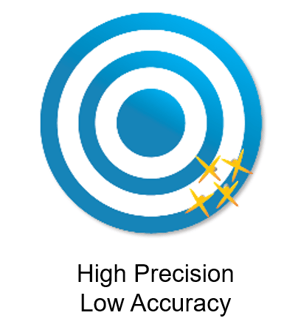
By: Project Management Academy on May 25th, 2021
Understanding Accuracy vs. Precision for the PMP® Exam
Precision and accuracy are seemingly similar concepts that actually have unique definitions and purposes. While some use these terms interchangeably, their differences are crucial for quality management questions on the PMP exam and other project management work.
This Project Management Academy guide can help you distinguish accuracy from precision and practice these concepts as a PMP credential holder.
Unlock your earning potential, download 7 Secrets to Passing the PMP Exam.
What is precision?
Precision describes how exact or closely clustered values are to each other without variation or deviation. When you take repeated measurements and find their values very close to each other, your results are precise.
Let’s say you are a project manager designing a machine that cuts pieces of wire. You use the machine to cut five pieces and take the following millimeter measurements: 115.0, 115.1, 114.9, 115.0, 115.0
These results are close together, but what if the target length per piece was 100 millimeters? Precision aims to reduce scatter but has nothing to do with how close values are to a target value. These values are precise but not accurate if the goal is 100 millimeters.
What is accuracy?
Accuracy describes the closeness of values to a true value – in other words, how correct they are compared to your target or goal. When you measure your results and find them very close to your target value, they are accurate.
Let’s say you want to use the wire-cutting machine from the example above to cut five 100-millimeter pieces, and you get these results: 100.1, 100.2, 99.8, 100.0, 99.9
Every piece is within 0.2 millimeters of the target value. This makes them accurate. However, the largest difference between values is 0.4 millimeters, which is less precise than before.
What is the difference between precision and accuracy?
Consider the following visual illustration of accuracy vs. precision:

The group of values is clustered closely, but nowhere near the bullseye’s center: precise, but not accurate. If a second group of values was clustered less closely but all falling near the bullseye’s center, the grouping would be accurate, but less precise.
Both precision and accuracy describe repeated measurements of results. However, they are not equivalent! You will need to understand the difference between accuracy vs. precision for the PMP exam.
Accuracy vs. precision for the PMP exam
PMP credential holders must remember accuracy is when a measured value is very close to the target value, while precision is when the values of repeated measurements are clustered without much variation.
- Precise measurements may not be accurate, and accurate measurements are not necessarily precise.
- Precision describes how close values are to each other: their exactness.
- Accuracy describes how close values are to a target value: their correctness.
As a project manager and potential PMP credential holder, you should aim to balance precision and accuracy, but you may prioritize one over the other depending on your project. For example, it may be more necessary for deliverables to be correct (accurate) to satisfy project requirements rather than being exactly alike (precise).
What else should you know about accuracy vs. precision for the PMP exam?
You should also know why these concepts matter to project managers. Precision and accuracy are crucial for creating high-quality deliverables. They can also impact cost evaluations and schedule estimates, so documentation is key.
Control chart: precision vs. accuracy PMP tool
Control charts can help you document precision and accuracy as a PMP credential holder. A control chart displays process data over time in relation to established control limits. You can use control charts to:
- Determine the stability and predictability of a process over time.
- Gauge precision by depicting how closely values are clustered or scattered.
- Assess accuracy by depicting how close measurements are to target values.
Let’s review a few more examples to help you prepare for questions on accuracy vs. precision for the PMP exam.
Accuracy vs. precision PMP examples
Example 1
Suppose you are designing an automatic pitching machine for baseball batting practice. To check the machine’s speed settings, you set it to pitch at 90 mph and take the following measurements:
- Pitch 1: 95.5 mph
- Pitch 2: 95.4 mph
- Pitch 3: 95.6 mph
- Pitch 4: 95.5 mph
- Pitch 5: 95.6 mph
These values are precise, or close to each other. However, they are not accurate, or close to the target value of 90 mph. You need to correct the machine’s speed to ensure a high-quality product.
Example 2
Let’s say you are testing the temperature of a refrigerator set to 35°F. You read the thermometer five times and register degrees Fahrenheit as: 34.7, 34.9, 35.0, 35.2, 35.3
Although the temperatures vary between 0.1 to 0.6 degrees, they are all within 0.3 degrees of the target. This makes these measurements accurate, but not quite precise.
Example 3
Imagine you are creating a toy car and racetrack, and you want the car to complete the track in about ten seconds. You test your design and find the following times:
- 1 second
- 0 seconds
- 1 second
- 9 seconds
- 0 seconds
These results are both accurate and precise: they are close to the target value and close to each other. Well done! Your deliverable fulfills its requirements and is of high quality.
Precision and accuracy are both vital concepts in project management. Your experts at Project Management Academy are ready to help you master these concepts and many others for the PMP exam. Talk to us today about getting the PMP exam prep training you need to pass the PMP exam and take the next step in your career!



